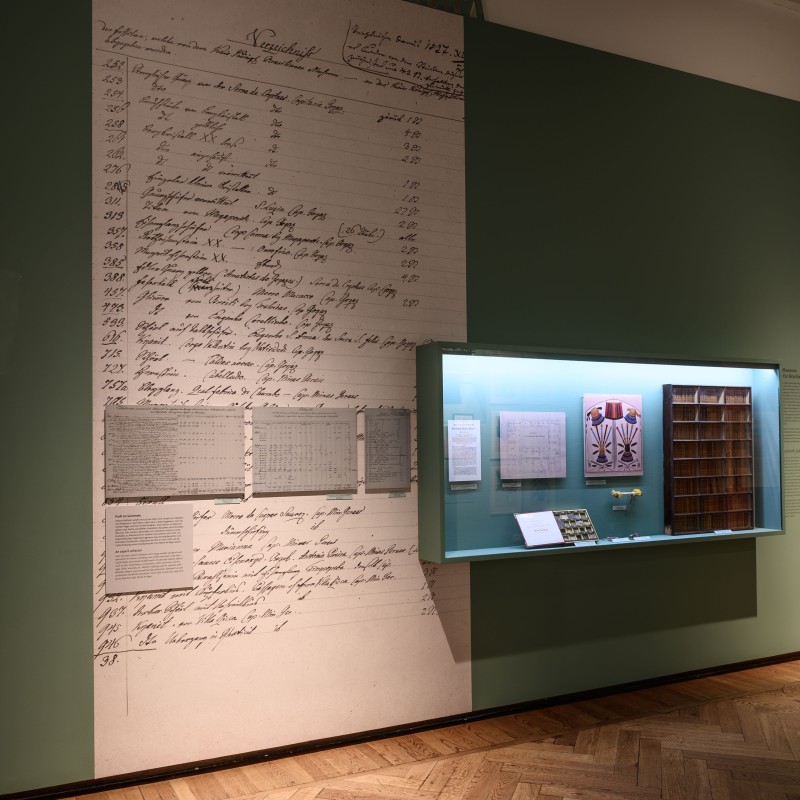Special exhibition: "BRAZIL. 200 years of relations"
07. June 2022
The new special exhibition "BRAZIL. 200 years of relations" can be seen from 8 June 2022 to 23 April 2023 (extended until
3 September, 2023!) in the four cabinets and two special exhibition halls (mezzanine level) at the Natural History Museum
Vienna.
The exhibition focuses on the fascinating diversity
of Brazil from the perspective of the centuries-old ties between Brazil and Austria with their global interactions. This common
history can be seen in many areas – politics, through major trade agreements, but also cooperation in science and culture.
Last but not least, at an individual level it is reflected in our behavior as consumers.
On Tuesday, 7 June 2022, at 10.30 a.m., the NHM Vienna invites to a press conference on the occasion of the new special exhibition.
BRAZIL. 200 years of relations
Please
register under: presse@nhm-wien.ac.at
On Tuesday, 7 June 2022, at 10.30 a.m., the NHM Vienna invites to a press conference on the occasion of the new special exhibition.
Venue: Natural History Museum Vienna, Maria-Theresien-Platz, 1010 Vienna
Special
exhibition, Cabinet 4
Admission: from 10.00 a.m.
Start: at 10.30 a.m.
Programme:
Welcome
and introductory words:
Dr. Katrin Vohland, Director General & Scientific Director
of the NHM Vienna and curator of the exhibition
Statements on the exhibition from the curatorial
team:
Dr. Christian Bräuchler, Head of the Botanical Department, NHM Vienna
Prof.
Dr. Sabine Eggers, Head of the International Osteological Collection in the Anthropological Department, NHM Vienna
DDr.
Martin Krenn, Head of the Archive for the History of Science, NHM Vienna
Cooperation partners
who have also taken up the theme of Archduchess Leopoldine & 200 Years of Independence of Brazil:
"Naturwunder
einer Neuen Welt: Brasilien in Schönbrunn".
Mag. Katrin Völk, Head of Department Austrian Federal
Gardens
"LEOPOLDINA. Furchtlos nach Rio"
Dr. Claudia Lehner-Jobst, Scientific
Director of the Porcelain Museum in the Augarten and curator of the exhibition
Followed by: Tour
of the exhibition with the curators
BRAZIL. 200 years of relations
The
close ties between Austria and Brazil can be traced back to the period of the Habsburg Monarchy. The marriage of Archduchess
Maria Leopoldina of Austria, the fourth daughter of Emperor Franz I and his second wife Maria Theresia of Naples and Sicily,
to the Portuguese heir to the throne, Dom Pedro, had not only political consequences but also a far-reaching impact on the
world of science. This exhibition gives an insight into the large-scale expedition launched to celebrate the wedding and supervised
by none other than Austrian Chancellor Klemens Wenzel von Metternich himself. A staff of distinguished scientists collected
and documented the exotic fauna and flora, as well as minerals and ethnological treasures, for four years in hugely challenging
conditions. The taxidermist Johann Natterer even stayed on after the expedition had ended, spending a total of 18 years in
the rainforests of South America and sending tens of thousands of objects and specimens back to Vienna. A selection of items
from his collections, today housed in the NHM Vienna and the Weltmuseum, is shown in the exhibition as well as some of the
countless herbarium sheets created by the botanist Johann Pohl.
At the same time, the exhibition
also addresses the darker side of relations between Austria and Brazil. Some of these aspects, such as the slave trade and
colonialism have massive effects right up to the present. Many others, however, continue today. These include ruthless, often
brutal behavior towards the indigenous population as well as the radical exploitation of coveted natural and mineral resources
– something we contribute to significantly through our behavior as consumers. These aspects are contrasted with examples of
the opportunities and limitations offered by science, as well as the knowledge and experience of indigenous peoples, in the
quest to find solutions that will benefit the world.
The majority of the exhibition is dedicated
to Brazil's unique natural habitats – the evergreen rainforest of Amazonia, the thousands of kilometers of Atlantic coastline,
the dense wilderness of the Atlantic Forest, the pale vegetation of the ‘White Forest’ in the Caatinga, the tropical swamps
of the Pantanal, the highly specialized grasses of the Pampa and the forbidding savannas of the Cerrado. Preserving the enormous
biodiversity and at least remnants of the original habitats with their abundance of plants and animals and their way of life,
is a tremendous challenge. Scientists from Austria and the NHM Vienna are working in a variety of ways with partners from
Brazil on research and renaturation projects. These projects, based on international collaboration, are being intensified
and becoming more and more globally oriented – a positive outlook for the future after 200 years of eventful common history.
Cabinet 2
Erzherzogin Leopoldine (Joseph Kreutzinger, um 1815)
und Dom Pedro von Portugal (Gianno, vo 1830)
(c) NHM Wien, Christina Rittmannsperger
und Dom Pedro von Portugal (Gianno, vo 1830)
(c) NHM Wien, Christina Rittmannsperger
Cabinet 2
Johann Natterer (Michael Sandler, um 1836)
und Johann Pohl (Franz Kadlik, 1823)
(c) NHM Wien, Christina Rittmannsperger
und Johann Pohl (Franz Kadlik, 1823)
(c) NHM Wien, Christina Rittmannsperger
"Rio de Janeiro", Robert Russ (around 1883)
Das Bild zeigt die von tropischer Vegetation umrahmte Hauptstadt des Kaisertums
Brasilien und ist im Saal 18 des NHM Wien zu sehen. Anlass für die Wahl dieses Bildthemas waren sicherlich die umfangreichen
Sammlungen, die durch die „Leopoldina-Expedition“ ans Museum kamen. Inspiriert wurde Robert Russ von den Aquarellen, die der
Expeditionsmaler Thomas Ender auf dieser Reise angefertigt hatte.
(c) NHM Wien
(c) NHM Wien

































